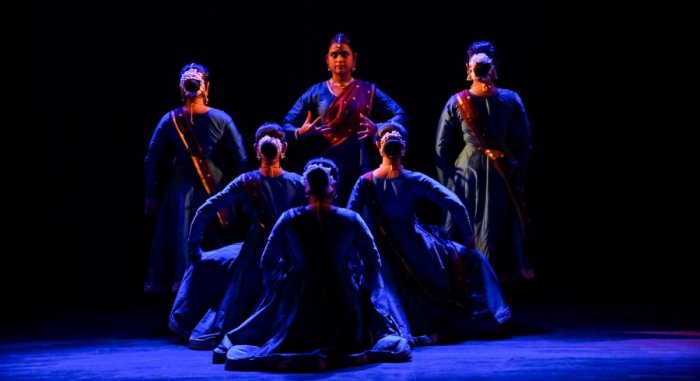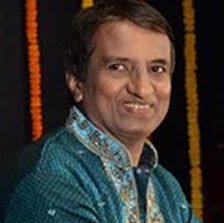
|   |

|   |
Fine programs of Kathak and Bharatanatyam - Vijay Shanker e-mail: vijaydance@gmail.com February 17, 2024 GKG Foundation's first programme in Mumbai Guru Kundanlal Gangani Foundation was established in recent years with the intention of promoting and propagating Indian classical dances, particularly the Jaipur Gharana of Kathak dance. The Foundation was founded by veteran Kathak maestro Pt Rajendra Gangani, who is among the most respected Kathak gurus in the country with several disciples across the globe. He is the son and disciple of Guru Kundanlal Gangani, hence the foundation is named after him. The foundation is working at different levels to promote Kathak with workshops and performances in different cities. For the first time the foundation organised 'Nritya Arpan' festival in Mumbai on 20th January at the new auditorium of PL Deshpande Academy. Dancers from different parts of India performed and the star performer of the evening was the acclaimed male dancer from New Delhi, Dheerendra Tiwari.  Nritya Arpan The programme started late and ended late too due to varied reasons. The performance commenced with delightful and rhythmic presentations by the Kalavarna troupe of dancers hailing from different parts of the country, who have completed their post diploma course in Kathak under the able direction of Guru Rajendra Gangani at Kathak Kendra in New Delhi. The dancers were Tina Das and Gauri Goyal from New Delhi, Ananya Gaur from Ujjain, Shravani Mahishi from Pune and Anagha Warrier and Sakshi Damani from Mumbai. It was interesting to watch the artistes dancing with fine coordination, synchronization, uniformity and rhythmic harmony, creating a fine impact on the audience. The dancers also recited the bols (dance syllables) whenever necessary that revealed their considerable command over the dance form. The dance presentations lasted for almost an hour.  Dheerendra Tiwari The star performer of the evening was Dheerendra Tiwari, who is considered among the most brilliant Kathak dancers of the younger generation. He is the ardent disciple of Guru Rajendra Gangani and has also sought guidance from veteran mentors like Shama Bhate and Aditi Mangaldas. Titled 'Pranamamyaham' he incorporated three choreographic pieces, namely Shivoham, Conversations with Shiva and Nandanar Charitram with choreography by Rajendra Gangani, Aditi Mangaldas and Shama Bhate. The Shiva numbers created a fine impact due to its mystical quality and the magnificence of the Lord. Combining elements of interpretative dance through expressions and bodily movements, coupled with intricate rhythmic patterns, reflected on his command over the dance form and his complete involvement in the presentation. For the first time, I saw a Kathak dancer trying to interpret the popular Nandanar Charitram, which is quite popular in the Bharatanatyam style. Nandanar is projected as an outcaste, an ardent devotee of Lord Shiva who anxiously waits to get a darshan of the Lord but is deprived. At a distance he can see only Nandi; he pleads and requests for a darshan and after a long wait is surprised to see a miracle happening when Nandi slowly moves away so that Nandanar is able to get a proper vision of the Lord; this particular moment is the dramatic pinnacle of the episode. Unfortunately the interpretation by Dheerendra was short and he could not create the necessary dramatic impact which was desired. The dancers received fine orchestral support from Yogesh Gangani on tabla, vocal by Samiulla Khan, sarangi by Mohammed Ayub and padant by Swarali Deshpande. The choreographic numbers of Dheerendra had musical support of Mahavir Gangani on pakhawaj and sitar by Prateek Pandit. The lights were by Sushant Jadhav. On the whole it was an interesting programme of music and dance with mystical quality. Well defined movements and expressions mark Sujatha's performance Accomplished Mumbai based Bharatanatyam exponent Sujatha Ramanathan performed at the India Habitat Centre's Stein auditorium in New Delhi on 2nd February. The performance consisted of some rare traditional compositions and innovative numbers that were executed with stylistic quality and natural expressions, leaving an indelible impression on the select audience.  Sujatha Ramanathan Sujatha commenced the performance with an unusual composition by Chinna Krishnadasar that combined intricate and stylistic movements interwoven with a hymn in praise of Lord Shiva. Swarajathi "Samba Shivayanave" in Khamas ragam and adi talam and jathi format was set by Guru Mahalingam Pillai. Of the hymn "Padigam" by saint poet Arunagirinathar of the 14th century, it is believed that those who recite this hymn will prosper and the nine planets will bring good fortune. A rare form of Shiva known as Veena Dakshinamoorthy was portrayed and praised and Parvati was described as the one who has shoulders that are firm as the bamboo. It was interesting to watch Sujatha dance with effortless ease and precision. Varnam "Danike thagu jananara" is a composition of Sivanandan of the Tanjore Quartet in praise of the last of the Maratha kings. In this number the Sakhi is in conversation with the king and she says her friend is the right person for him and she is pining to meet him. The Sakhi praises the king as well. Sujatha learnt this item from Guru Lata Raman, senior disciple of Guru Mahalingam Pillai. With abhinaya pertaining to the plight and restlessness of the nayika, Sujatha revealed her command over expressions. "Raas Antara" portrayed the magnificent flute player Krishna in which his music mirrors the harmony that is established in each devotee and the innate joy that resides in every being. This beautiful number was danced with joy and happiness, forming a fine combination of elegant movements and eternal bliss, experiencing divinity. After the light hearted Javali "Nee maatale", Sujatha concluded her performance with the composition by Balamuralikrishna. The Thillana was a fine exposition of stylised and well defined movements, danced to complex rhythm, winning the appreciation of the audience. Sujatha received fine orchestral support from the commendable singing by Sudha Raghuraman, nattuvangam by Sridhar, mridangam by Satish Krishnamurthy and flute by Raghuraman. Sujatha deserves to be seen more often by larger audiences.  Vijay Shankar is a Kuchipudi and Kathakali exponent, teacher, bilingual journalist, arts critic and actor. |